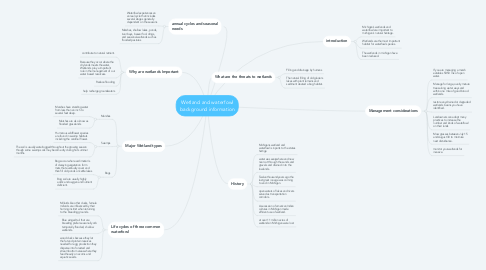Wetland and waterfowl background information
by Gage Martinus

1. Major Wetland types
1.1. Marshes
1.1.1. Marshes have standing water from less than an inch to several feet deep.
1.1.2. Marshes are also know as flooded grasslands
1.2. Swamps
1.2.1. Humorous wildflower species are found in swamp habitats including the cardinal flower.
1.2.2. The soil is usually waterlogged throughout the growing season though some swamp soils may become dry during hot summer months.
1.3. Bogs
1.3.1. Bogs occur where acclimation's of decaying vegetation form mats that eventually cover and then fill old ponds or kettle lakes
1.3.2. Bog soil are usually highly acidic and oxygen and nutrient deficient.
2. Why are wetlands Important
2.1. contribute to natural nutrient.
2.2. Because they occur where the dry lands meets the water, Wetlands play a important role in the management of our water based resorcess.
2.3. Reduce flooding
2.4. help recharge groundwaters
3. annual cycles and seasonal needs
3.1. Waterfowl experiences an annual cycle that includes several stages generally dependent on the seasons
3.2. Marshes, shallow lakes, ponds, river bays, beaver fool dings, and seasonal wetlands such as flooded pastures
4. Life cycles of three common waterfowl
4.1. Millards like other ducks, female millards are influenced by their homing instinct when returning to the breeding grounds.
4.2. Blue winged tail that are breeding prefer seasonally orb temporally flooded, shallow wetlands.
4.3. wood ducks because they lat the fat and protein reserves needed for egg production they disperse into forested and stream bottom areas where they feed heavily on acorns and aquatic seeds.
5. introduction
5.1. Michigan's wetlands and waterfowl are important to michigan's natural heritage.
5.2. Wetlands are the most important habitat for waterfowl species.
5.3. The wetlands in michigan have been reduced.
6. History
6.1. Michigans wetland and waterfowl is inports to the states hertige
6.2. water was everywhere and new river cut through the sands and gravels and drained in to the lowlands.
6.3. Twelve thousand years ago the last great ice age was coming to end in Michigan.
6.4. open waters of lakes and rivers served as transportation corridors.
6.5. A secession of american Indian cultures in Michigan made efficient use of wetland.
6.6. at over 11 million acres of wetlands in Michigan were lost.
7. What are the threats to wetlands
7.1. Filling and drainage by humans
7.2. The natural filling of old glaciers lakes with plant remains and sediment created a bog habitat.
8. Management considerations
8.1. If you are managing a marsh eatables 50:50 mix of open water.
8.2. Manage for large, overly mature trees along water ways and within one mile of good brood wetlands.
8.3. restore any drained or degraded wetlands basins you have identified.
8.4. Landowners can adopt many practices to increase the number and kinds of waterfowl on their lands
8.5. Mow grasses between July 15 and August 30 to minimize nest disturbance.
8.6. monitor your wetlands for invasive.



